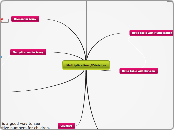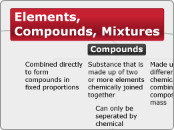Mathematics for Elementary Teachers
Rational Numbers
a number that can be written as a ratio of two integers
a/b where both a and b are integers
Ratio
Used to seperate two sprate things
3 oranges for $1
Fractions
Not all fractions are rational
Quotient
interpreting the fraction as a division problem
2 2 divided by 3 equal 0.6666...
3
Part-to-whole
the whole is partitioned into b equal parts of which a of those parts are selected
Ex. 2 Total of 2 of those 3 parts are used
3 Whole is divided into three equal parts
Multiplication & Division
Division
Context
Measurement (Repeated Subtraction Model):
Characterized by using a specified quantity to create groups (or partitions) of a specified size (amount) and determining the number of partitions (groups) that can be formed
Ex. Sally has 8 eggs and a recepie for brownies requires 2 eggs. How many batches fo brownies can Sally make?
KNOW: Size of group
FIND: Number of partitions/groups
Partition (sharing):
Characterized by distributing a specified number of partisions( groups) and determining the size ( amount) in each partition (group)
Ex. Billy comes to school with ten pencils. He Decides to share the pencils with 5 friends. How many pencils does each friend get?
KNOW: 5 groups
FIND: amount in each group 2
Multiplication
Cartesian Product:
Characterized by finding all the possible pairings between two or more sets of objects
Ex. Sara has 4 Jackets and 3 scarves. How many jacet and scarve outfits can she wear?
J1-s1, s2, s3, (J1,s1)
J2- s1, s2, s3 (J2, s2)
J3- s1, s2, s3
J4- s1, s2, s3
Area (Arran) Model:
Characterized as a product of two numbers representing the sides of a rectangular region such that the product produces unit size squares
Ex. Tom is tiling his bathroom that measures 10ft by 15ft. To purschase the tile he needs to find area of bathroom floor. What is the are of the bathroom floor? 10*15
Properties of Multiplication
Communative Property:
If a is an element of a whole number, b is an element of a whole number, then a*b=b*a
a= 5, b=7
a*b is 5*7 and b*a is 7*5 not the same but produce the same value
Closure Property:
if a is an element of a whole number and b is an element of a whole number then (a*b) is an element of a whole number
Ex. a=5 and b= 7, 5*7 is 35, 35 is an element of a whole number
2 Base Models/ Context for Multiplication
Repeated Addition- Continuous:
Characterized by repeatedly adding continuous quantities a specified number of times
Ex. During the week, Monday thru Friday Sandra practice the piano 30 minutes a day. How long did she practice this week
30+30+30+30+30... 30*5
Repeated Addition- Discrete:
Characterized by repeatedly adding a quantity of discrete objects a specified number of times
Ex. Sammy's brother and sister both gave him 2 cars for his birthday. How many cars did he get? 2+2... 2*2
Numeration Systems
Hindu-Arabic
Used base 10
0 -9 is used when 10 is reached a new palcement value is formed
Roman
Letter represent a number and depending on the position a number is created
Mayan/ Babylonians
Babylonians used base 60
In base 60, 0-59 units are grouped and when 60 is reached a new placement value is created
Mayans used base 20
In base 20, 0-19 units are grouped and when 20 is reached a new placement value is created
Egyptians
Used symbols and position of the symbol determined the number
Tally System
Using sticks and grouping in fives
Sequences
Sequence: an ordered list of objects, events, or numbers
Types of Sequences
Recurrence relationship Sequences
Defines a sequence in which the current term is dependent on previous term(s)
Difference: multiply by 2 then add 1
13 multiplied by 2 equals 26 then add 1
Product of 1st term 13
ex. 6, 13, 27, 55..
Geometric Sequences
Sequence of numbers with a common ratio
common ratio -1/2
ex. 8, -4, 2,-1,..
Arithmetic Sequences
Sequences or numbers with a common difference
Adding 2 to each time will create the next number
common difference of 2, 4, 6, 8 is 2
ex. 2, 4, 6, 8, 10
Composed of elements (objects found within)
Number Theory
LCM (least common multiple)
Ex. LCM (4, 6): 12
Multiples of 4: 4, 8, 12, 16, 20...
Multiples of 6: 6, 12, 18, 24, 30...
GCF (greatest common factor)
Ex. GCF (4,6): 2
Factors of 4: 1, 2, 4
Factors of 6: 1, 2, 3, 6
Divisibility
Divisibility Tests
2, 3, 4, 5, 6, 8, 9, 10
4 statements
a is a factor of b
b is a multiple of a
a is a divisor of b
b is divisible by a
3|15
3 is a factor of 15, because 15= 3* 5
15 is a multiple of 3, because 3*5= 15
3 is a divisor of 15 because 15/3=5
15 is divisible by 3 because 15 divided by 3 is 5
2 distinct wats
a/b: a divided by b
a|b: a divides ("divides into") b
Composite Number
a number with more than two factors
Ex. 8 is a composite
composed of 1,2,4, and 8
Prime Number
a number with exactly two distinct factors (1 and itself)
Ex. 23 is prime
can only be divided by 1 and 23
Odd Number
is a number that can be wrtten as (2 * n) + 1
Ex. 9 odd
(2*4)+1
Even Number
is a number that can be written as 2 * n
Ex. 12 even
2*6
Addition & Subtraction
Subtraction
Four Fact Families
relates the sum of 3 &4
3+4=7
4+3=7
7-4=3
7-3=4
European Algorithm
Adding method in order to subtract from numbers
Properties of Subtraction
Identity Property of Subtraction
If a is an element of W can we say a-0 = a and 0-a=a? NO
Ex. If a=4 then
a-0= 4 but 0-a= -4
Associative Property of Subtraction
If a is an element of W, b is an element of W and c is an element of W can we say
(a-b) -c = a- (b-c)? NO
Ex. If a=5 and b=4 and c=3
(a-b)-c=-2 and a-(b-c)=4
-2 is not equal to 4
Communative Property of Subtraction
If a is an element of W and c is an element of W can we say
a-b= b-a? NO
Ex. If a=5 and b=7
a-b=-2 and b-a=2
-2 is not equal to 2
Closure Property of Subtraction
If a is an element of W and b is an element of W can we say (a-b) an element of W? NO
Ex. If a=7 and b=5
a-b= -2
-2 is not a whole number
Context
Missing-addend:
the need to determine what quantitiy must be added to a specified amount to reach some target quantity
Ex. Kelsie has 6 blocks. She wants 10 blocks. How many blocks does Kelsie need?
Comparison:
comparing relative sizes of two quantities to determine how much smaller one of the quantities is compared to the other quantity
Ex. Emily read 5 books. Jim read 3 books. How many more books did Emily read than Jim?
Take Away:
starting with an initial quantity and removing (take away) a specific amount
Ex. Vince came to class with 5 pieces of candy. He gave 3 pieces away. How many pieces of candy does Vince have?
Addition
Methods
Scratch
Addition done as regular but the "carry over number" is added to the following place value number
Any Column First
Addition is done using place values. Zeros are inserted after the number as "place holders"
Left to Right
Start with the begining place value and work backwards. Make sure to place zeros as "place holders"
Low Stress
Pyramid style. The sum of the first two numbers will begin the pyramid. The following number is added to the ones place but not to the tenths.
Properties of Addition
(W= set of all whole numbers)
Communative Property of Addition
If a is an element of W then a +b = a+b
2 sets, one contains a objects and other contains b objects the two sets will contain the same a+b number of objects
Identity Property of Addition
If a is an element of W then
a+ 0 = a = 0+ a
Two sets , one contains a of jects and the other contains zero objects then when combined the new set will contain a objects
Associative Property of Addition
If a is an element of W, b is an element of W and c is an element of W then
(a +b) +c = a+ (b+c)
The order of the addition will not matter because both sets will bring the same result
Closure Property of Addition
If a is an element of W and b is an element of W is (a +b) an element of W
Sum of two whole numbers is another whole number.
2 Base Models/ Context for Addition
Addition- Continuous
Characterized by the combining two continuous properties
Ex. Paul goes to the gym spends 10 min jogging and 20 min walking. How long are his workouts?
Addition- Discrete
Characterized by combining two sets of discrete objects
ex. Bob has 3 apples and 2 oranges. How many pieces of fruit does he have?
Sets
Definied as a collection of objects
Empty Set
Nothing contained in the set
symbol: { }
Complement of a set
Elemets not contained within specific set
Equivalent Set
Same number of elements but do not contain the same elements
ex. {1, 2, 3} ~ {a, b, c}
Both sets contain 3 elements
Equal Set
Identical elements found in both sets
ex. {1, 2, 3} = {2, 3, 1}
Although different order both sets contain same elemets
Proper Set
A subset of another set in which there is at least one element of the other that is not in the subset
Subset
Set of objects in which all objects in set are contained within another set
Universal Set
Collection of all objects in problem
Problem Solving
Steps
4. Look back (reflect)
Is there an easier way to solve it?
Does it need to be revised?
Does the answer make sense?
Subtopic
3. Carry out the plan
Revise the plan if necessary
If the solution is not visible, rethink the plan
Be persistant with your current plan
2. Devise a plan
Use a model
Create charts, lists, and use objects
Work backwards
Solve a simpler problem
Use an easier problem based on your current problem
Guess and check
Think of solutions and plug into the problem to check answer
1. Identify the problem
Understand the problem
George Polya (1887-1985)
Major contribution was his work in Problem Solving
"..'solving a problem means finding a way out of difficulty, a way around an obstacle, attaining an aim which was not immediately attainable'.." (Billstein 2)
Quote by George Polya pulled from Mathematical Discovery and re quoted in A Problem Solving Approach to Mathematics for Elementary School Teachers 11th edition by Rick Billstein.
Mathematician and Teacher of 20th Century









